The Apple iPhone 6s and iPhone 6s Plus Review
by Ryan Smith & Joshua Ho on November 2, 2015 8:00 AM EST- Posted in
- Smartphones
- Apple
- Mobile
- SoCs
- iPhone 6s
- iPhone 6s Plus
System Performance Cont'd
Moving on towards our more GPU-bound workloads, we use our standard test suite of benchmarks like GFXBench and 3DMark to get a good idea for performance. Unfortunately, due to the move to iOS 9 the Unity engine version used in Basemark X is no longer working so for now we’re left with 3DMark and GFXBench. There is also Basemark OS II’s graphics test, but this is embedded in a larger benchmark with CPU and storage performance tests.

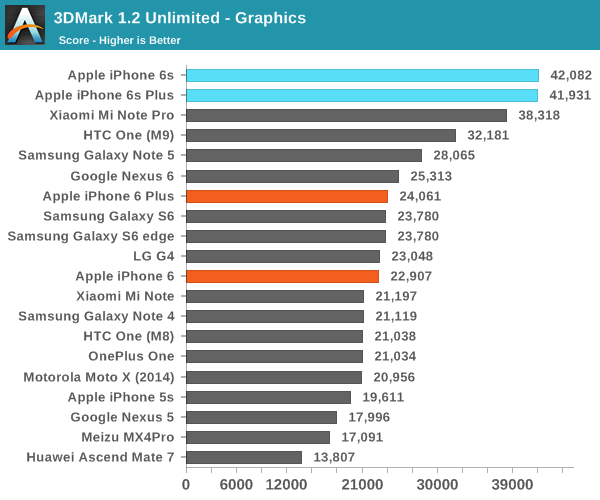
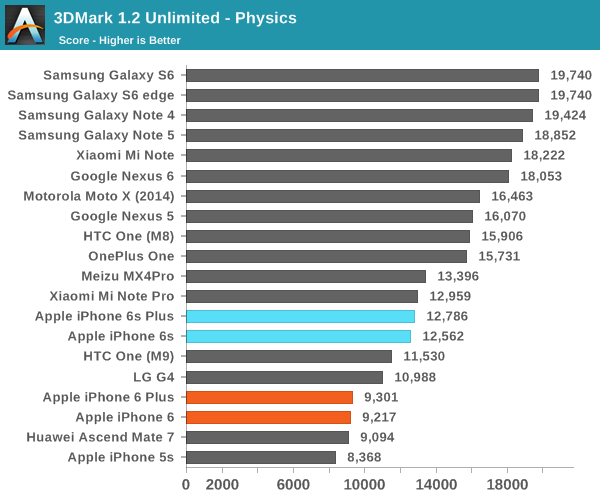
As always with 3DMark, there are some issues in the data structures used. Due to the data dependencies present within the physics test, it is necessary for the CPU to stall for data to be committed to memory before continuing on to the next portion of the test instead of executing instructions in parallel. This strongly reduces the practical performance of the CPU because the architecture is primarily focused upon instruction-level parallelism to deliver major performance gains. However, due to the strong showing in graphics performance the iPhone 6s’ still manage to take the lead.
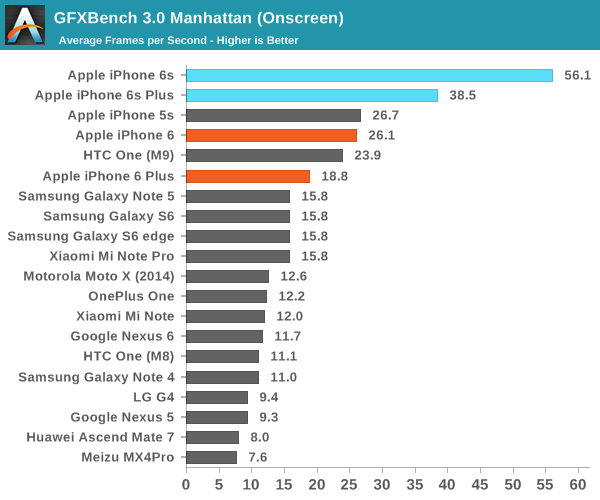
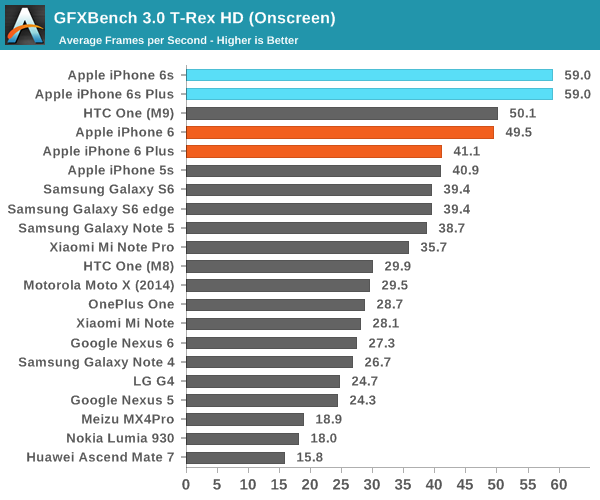
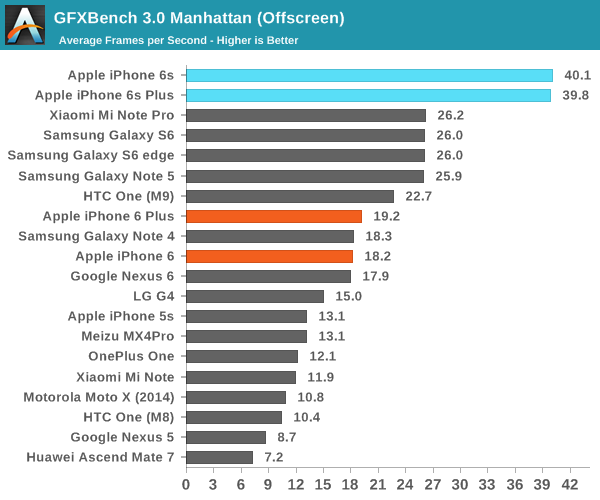

In GFXBench, the A9 SoC just shows absurd performance. It’s strange to think about how the iPad Air 2’s GPU seemed incredibly quick at the time but with the A9 Apple has surpassed that level of performance in their smartphone SoCs. The move to a new generation of PowerVR GPU IP, in addition to the move to a FinFET process node are really the drivers for this kind of performance improvement.
Overall, the Apple A9 SoC is the best SoC in any phone shipping today. In cases like web browsing, gaming, and even just going through the UI it’s quite evident that this new SoC is a major factor in improving performance and smoothness across the board. Something as simple as visiting some popular tech websites will show this, which really goes to show how much “specs” still matter due to their influence on user experience.
NAND Performance
At this point is almost goes without saying that storage performance is important, but in a lot of ways the testing here is still in its early days. In the case of the iPhone 6s we’ve discussed what distinguishes its storage solution from others in this industry, but for those that are unaware the iPhone 6s uses PCIe and NVMe instead of a UFS or eMMC storage solution. In a lot of ways, this makes the storage on board closer to the SSD that you might find in a more expensive PC but due to PCB limitations you won’t necessarily see the enormous parallelism that you might expect from a true SSD. In the time since the initial results we've found that all of our review units use Hynix-supplied NAND. In order to test how this storage solution performs, we use Eric Patno’s storage test which allows for a simple storage test comparable to AndroBench 3.6.
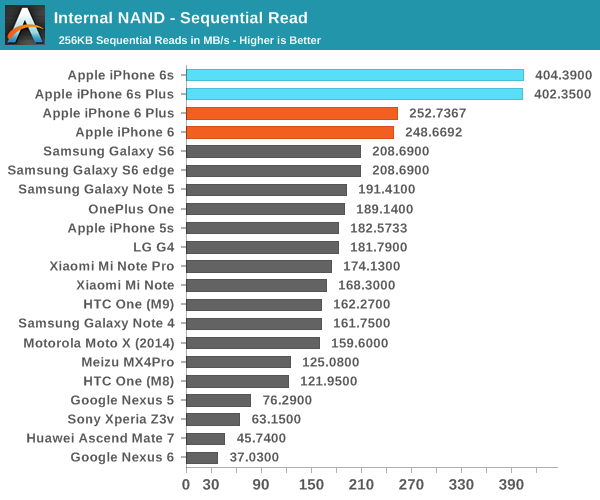
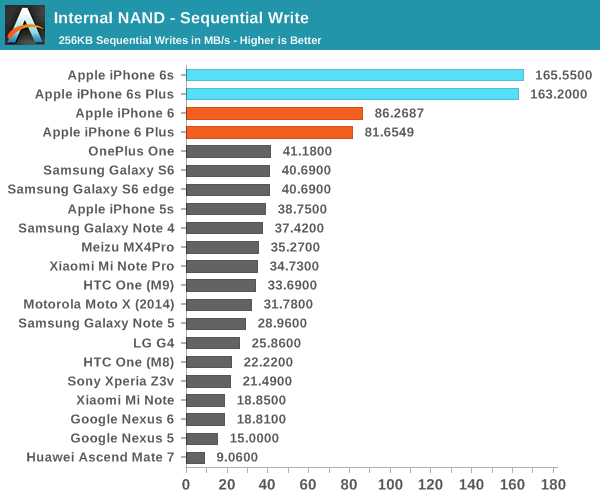
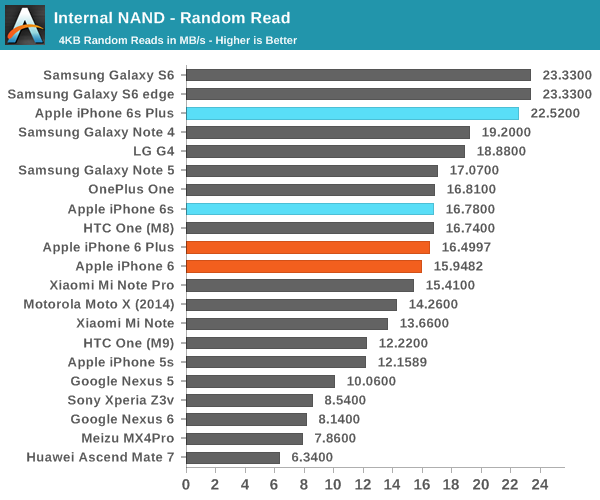
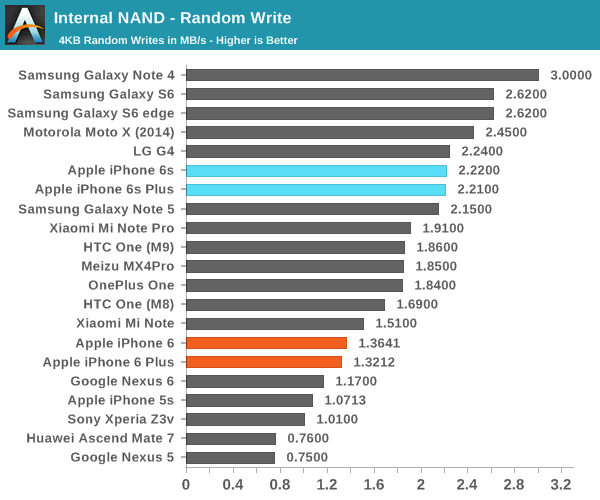
Here, we can really see the enormous performance improvements that result from a combination of TLC NAND with an SLC cache, along with the new NVMe protocol which allows for low CPU overhead and removes architectural bottlenecks to storage performance. This should allow for things like faster burst photos and faster app updates. Downloading and updating apps on the iPhone 6s feels noticeably faster than it is on the iPhone 6, to the extent that small apps feel like they install almost instantly when I’m on a WiFi connection fast enough to saturate storage bandwidth.










531 Comments
View All Comments
akdj - Wednesday, November 4, 2015 - link
You should read 'long pages' like the "Final Words" section more often. Help on your spelling as well as getting your ...a point acrosstuxRoller - Monday, November 2, 2015 - link
Read the review.I'm not an apple "fan", but it's clear they have, BY FAR, the best hardware in a phone that you can buy (storage, battery, cpu, memory, gpu).
While it's true this was an off year for android soc (thanks Qualcomm), that even highlights all the more the massive improvement this phone is over last year's.
Caliko - Monday, November 2, 2015 - link
Apple is notorious for NOT sharing a penny for media/reviews/placements.You just sound silly to those in the know. Almost funny.
Bfree4me - Tuesday, November 3, 2015 - link
@djsvetljo Kudos to Anand tech for another very thorough review done on the venerable iPhone, but I think that you may have a point. After reading this review, I went back and looked at the Galaxy NOTE 5/Edge review published 4 weeks ago and could not for the life of me find a similar exhaustive analysis of the Octa Core ® CPU that the Korean maker deploys. No pictures of the SOC or GPU. But hey, they are not obligated to so either. But good points nonetheless.jospoortvliet - Wednesday, November 4, 2015 - link
That SOC/core was extensively reviewed in earlier articles and a known quantity...NYU87 - Tuesday, November 3, 2015 - link
You didn't even read the review? Jesus Fandroids are more retarded than I thought.Infy2 - Monday, November 2, 2015 - link
While iPhone 6s may be full of engineering triumphs and technological marvels, apart from 3D Touch, I don't believe it will make much difference in normal day-to-day use compared to older iPhones.NEDM64 - Monday, November 2, 2015 - link
Exactly. Hence the name: iPhone 6S (S for speed, not 7), and the ZERO exterior design changes.It's a phone you buy when you buy new.
ASEdouardD - Monday, November 2, 2015 - link
For the 6s, I don't feel it changes much of anything. The 6 Plus though had some trouble having smooth animations across the board with transparency on (Apple annoys me with their obsession with non necessary transparency effects that slow down phones and laptops for no good reasons). With the 6s Plus everything is smooth and snappy.CBone - Tuesday, November 3, 2015 - link
What good is all this power when everything runs and looks the same at the same resolution? I would have liked actual measues of real differences. 52 seconds to install vs 30 seconds on the 6s, 12 seconds to edit convert and transfer vs 13 on the 6s, etc. We already know that the usual benchmarks and SoC specs will be heavily in favor of the new phone but the actual use is nearly the exact same experience aside from hardware enabled changes like camera hardware changes and 3d touch and artificial differentiation like live photos and siri. It would be nice to explore a little further than canned benches for those aspects.